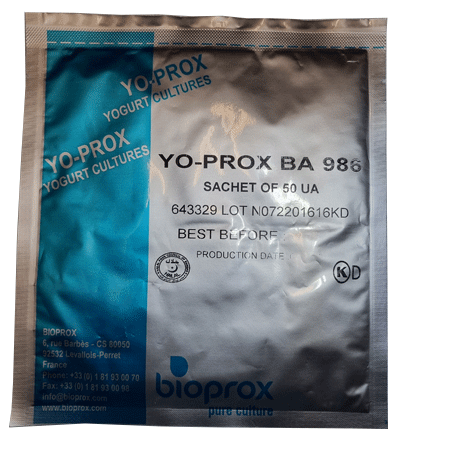Dosage and pack size
- Large size (50UA in foil sachet) will inoculate 500 to 1,700 litres of milk depending on dosage used
- Medium size (16.6 UA in a large screw cap bottle which is 1/3 of a large pack) will inoculate 165 to 560 litres of milk depending on culture dosage used
- Small size (7UA screw cap bottle which is 1/7th of a large pack) will inoculate 70 to 240 litres of milk depending on dosage used
- An approximate guide for usage is 1 to 2 Drop mini spoons (1 Drop = 1/64th teaspoon) to 1 litre of milk. But this dosage level in not critical and can be increased or decreased without problems being caused. Add more culture for faster incubation or if the mix has added solids, additional culture may also be required (eg with added cream, sugar, powder etc. the cultures may have a slower acid production rate).
Acidification: Medium to Fast
Texture: This is the thickest of the yoghurt cultures due to the high level of ‘water binding’ ability of the cultures. It has a very smooth mouth feel.
Flavour and Aroma: Mild aroma with medium yoghurt flavour
Yoghurt 986 is suitable for tub set and stirred yoghurts, Greek style yoghurts, thick body drinking yoghurt, strained yoghurt (Labnah) with strong flavour. It has a fast incubation like Yoghurt 747 but a different flavour and texture profile.
To make yoghurt
For best results for yoghurts (whether for smoothies, drinking yoghurts, stirred, natural set (pot set), use a milk with a high level of natural fat and protein. Homogenised or non-homogenised milks are both suitable. Add skim or whole milk powder to the milk as required or nil powder if that is required:
- For Greek Style yoghurt, add up to 4% – 6% milk powder to the milk
- For a traditional yoghurt, add up to 2% milk powder to the milk
- For a drinking style yoghurt, just use straight good quality milk, with nil additives.
Add cream and sugar at your personal preference, they are for flavour and do not affect the texture. Heat the yoghurt mix too greater than 92°C for approximately several minutes (stirring constantly to avoid burning) and then cool to incubation temperature between 37°C – 43°C, add the starter culture and incubate overnight until the desired acidity is reached before cooling. Incubation at 37°C will provide a slower incubation but slightly thicker yoghurt while incubation at 43°C will provide faster incubation with slightly less thickness.
Note when adding starter culture to fortified milks, dissolve the culture in 20ml of milk prior to adding it to the yoghurt mix.
I do not recommend adding ‘thickeners’ eg stabilisers, starches, gelatines… to homemade yoghurts, they can be hard to source, are expensive, it may not be the correct ingredient anyway, it complicates the process but simply it is not necessary.
The time that it takes to incubate yoghurt to the desired acid level will vary depending on:
- How much culture is added;
- How many solids are added (or nil solids added);
- The temperature of incubation;
- The final level of acidity required
A simple taste test is the best tool that you have as a home yoghurt maker to know when that desired acidity is reached. It needs to have formed a gel to be finished. If the gel is too acidic at this stage, very very gently stir in some honey or sugar to reduce the acid taste. If the yoghurt is not acid enough then continue incubation. When the yoghurt tastes right, finish the incubation by placing it in the fridge. If the acid level is not high enough, continue incubation.

